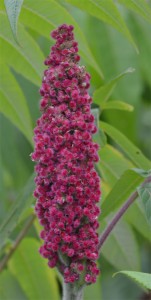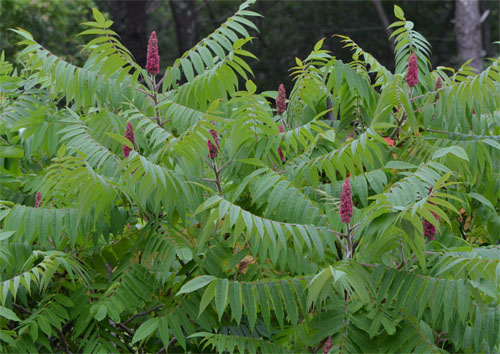
fruit of the staghorn sumac Cummaquid July 3 2011
Staghorn sumac is a large (10 feet and up), open-spreading shrub or tree with a flattish crown. The branches look like the antlers of a deer. The plants are currently adorned with red velvety looking fruit. The plant is native to southern Canada and the eastern US. Back in the day native American Indians made a lemonade-like drink from the fruit. Tannery workers used the tannin-rich bark and foliage as a tanning agent. All parts of the plant can be used as a dye or dye fixing agent.
Sumac can grow rapidly, but requires direct sunlight to persist. It is stubborn – I’ve cut back a staghorn sumac stem in falls past and every year it has come back to sprout a 10 foot stem. Eradication, if that is your choice, may involve getting rid of the root stock. However, that is not my intent since the plant has a place and role in the open oak woodland.

Rather than using the weed wacker, one might try drinking the shrub away. Really – the following recipe is an adaptation of Steven A. Krause’s Wines from the Wilds:
Fruit should be gathered soon after turning red, as the longer the remain on the bush the more tasteless they become. Fully ripe staghorn sumac should taste sour. Do NOT extract juice with boiling or hot water, or else too much tannin will be extracted and will result in an astringent and bitter wine.
- 5 lbs ripe staghorn sumac berries
- 3 lbs finely granulated sugar
- 1 gallon water
- 1 crushed Campden tablet
- 1 tsp yeast nutrient
- 1 packet Lalvin 71B-1122 (Narbonne) or RC212 (Bourgovin) wine yeast
Wash to remove dust and insects. Put clusters in container, cover with water and mash or crush the berries with 4″ x 4″ piece of hardwood. Strain juice into primary through clean muslin to remove plant hairs and pulp. Add sugar, crushed Campden and yeast nutrient and stir well until all sugar is dissolved. (NOTE: Sugar could be dissolved in boiling water beforehand but must cool to room temperature before pouring over sumac fruit.) Cover primary and set aside 12 hours. Add activated yeast, recover and stir daily. After 14 days of fermentation, transfer to secondary, and fit airlock. You should have more than one gallon of wine, so use a one-gallon secondary and a 1.5-liter wine bottle fitted with a #2 bung and airlock. The wine in the smaller secondary is what you will use to top up the one-gallon secondary. Rack, top up, and refit airlock every 30 days wine is clear and drops no sediments during 30-day period. Stabilize, sweeten to taste if desired, refit airlock, and set aside for 10 days. Rack into bottles and age at least one year before drinking.
Leave a Reply